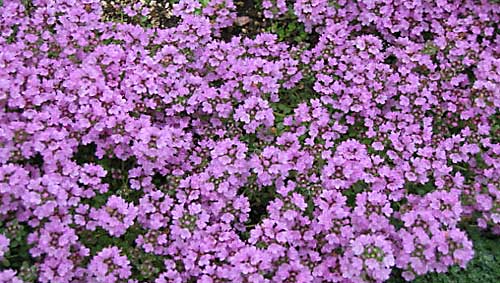A lovely little perennial plant hardy to zone 5. It likes poor soils that are well drained and full sunshine. It does not need much watering and can withstand some drought. Given this it is a pretty carefree plant the will bloom year after year with little care. It makes a great ground cover plant, or it can be used between stepping stone, in planters or on rockeries. Deer don't eat it.
Description. A low growing spreading perennial evergreen herb growing only 3-5 inches high. It has small dark green shiny ovate or elliptically lanceolate leaves that are arranged in opposite pairs along the stems. Many have reddish brown spots along their margins. The stems are hairy all over can become woody but do not rise far above the ground. There are many flowerless shoots very close to the ground. Flowering shoots rise up to about five inches and The flowers appear in July and August and are pink to light purple in color. Each flower is about ? inch (6mm) long and fused into a tube at the bottom end spreading out with one lobe at the top and three spread across the bottom of the flower. The stamens are long a protrude out from the flower. The flowers are arranged in whorls ascending the stem. The leaves of the plant have a very strong scent especially when crushed or bruised.
Growing. Germination of thyme seed can be erratic so seeding indoors in pots or plug trays is by far the best way. This way small seedlings can be transplanted as they grow while other are only just beginning to sprout. Grow on in individual pots until large enough to plant outside. Barely cover the seed and keep the potting soil slightly moist and warm. Don't plant outside until after frost danger has past. Although thyme can be sown directly outside the erratic germination often means that the seed area can be overrun with weeds before all the plants have sprouted. More work is needed to keep the area weed free.
Location and Care. Prefers full sun in a well drained soil in dry locations. It actually prefers poor soils and will produce much better flavor leaves under these conditions. It will grow on most soil types but cannot tolerate wet or waterlogged soils. IT does need a location that will protect it from cold winds and hard wet winters. In the shelter of a house or next to a hedge fence or bush is ideal. Once established it needs very little water it is quite drought tolerant and after it is fully established no further watering should be needed unless there is a very long drought. For the healthiest plants they should be trimmed after flowering to help promote new growth and prevent the woody stems from sprawling all over the place. Smaller patches can be trimmed with sheers while larger once can be done with a lawn mower with the blade set high. This low growing plant is often used as a ground cover. It is a very tough plant that can tolerate a lot of abuse including being walked on. For this reason it is often used as a lawn replacement or between stones on pathways. It also makes a great rockery plant or for areas of stones where few other plants will grow, it will even grow on stone walls. It will take some care to become established, water frequently in the first year to allow the plant to put down roots and begin to grow. If intended as a ground cover or lawn replacement it will need some weeding to begin with until the plants grow to fill all the gaps. It usually then creates a dense mat that covers the whole ground and prevents weeds from germinating but some weeding will be needed until this point is achieved.
Container Growing: All varieties of thyme are happy growing in containers. Creeping thyme is well suited to pots on decks and window boxes as it can trail over the edges and down the sides. Give the pots full sun, use a easy draining soil mix which is low in nutrients. Sandy soil mixed with a little potting soil is idea. (don't use seashore beach sand because of the salt). Water only occasionally, if the leaves begin to loose color it's a sign they need water. Don't feed very often nutrients can actually hamper the plant and will make the leaves less flavorful. Trim back the growth after flowering. Pots should easily withstand winters if placed in a sheltered location away from strong winds and cold spots.
Harvesting: Thyme is evergreen, so it can be picked fresh all year round. If you're picking to preserve it, then the best time to harvest is before it flowers. Either dry the leaves, or put them in a vinegar.
Culinary uses. Thyme is the major ingredient in the herb mix "bouquet garni". It is often added to soups, stews, marinades, vegetable dishes and goes well with squash and mushrooms. It can also be added to stuffing for poultry. It can be added to butters, spreads and vinegar for additional flavoring on salads.
Medicinal Uses. Thyme is a great digestive aid as it aids in breaking down fatty foods. It has strong antiseptic properties and the essential oil is a strong anti-bacterial and anti-fungal. A tea made from the leaves can be used as a gargle for sore throats and infected gums. The oil is added to toothpastes mouthwashes and gargles. A few drops the oil in bathwater can help to ease rheumatic pain and the oil is also used in massage oils. There are even some reports saying it is helpful to ease hangovers.
Other names. Broadleaved Thyme,: broad-leaved thyme large thyme, greater wild thyme, lemon thyme, wild thyme









